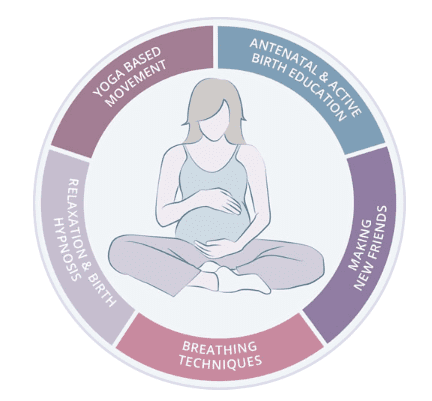



At The Baby Show Birmingham last weekend I was lucky enough to be invited to attend a pregnancy workshop with The Daisy Foundation. This 40 minute session was a small taster of the Daisy Foundation classes held across the UK.
There are two types of classes – Daisy Birthing – an active antenatal class for pregnant women, and Daisy Parent- a complete birth preparation and baby care workshop.
The session I attended was a Practical Labour Breathing Techniques workshop – this was of real interest to me as we are expecting our second baby in September 2016. My labour with Erin was LONG – VERY LONG, and despite attending pregnancy yoga and learning the importance of breathing, it all went a little to pot on the day, with my anxiety taking over and me spending the majority of time taking short sharp breaths. At one point this led to an almost hyper ventilation – with my entire face feeling like I had pins and needles – not a good start to the calm and controlled labour I had hoped for!
I was keen to hear about some different practical labour breathing techniques and the massage opportunities that I can hopefully encourage your birthing partner to help with when the big day arrives!
My session was hosted by Fi, who started by talking us through the 3 most important breathing techniques during labour.
Labour Breathing Techniques and Exercises
Fi described how a contraction tends to feel like a wave, starting slowly, peaking, and then fading away. By teaching your body to breathe through the wave, you can wear out tension, and help your body to create oxytocin – making labour feel more instinctive and easier to manage.
The first labour breathing technique, useful in the early stages is the Centred Breath – this breath involves breathing in for a count of four, and out for a count of 8, ideally in through the nose and out through a relaxed open jaw. This breath helps fill the lungs with air, oxygenate your blood and help muscle fibres to relax. This breath can be used to breathe through early contractions, or during times of intervention, such as when you are having an epidural, or examination.
By counting in for 4 and out for 8, it is harder to take the short sharp breaths that can cause tension in your shoulders and face.
When the intensity starts to rise and the contractions get stronger, the Escalator Breath labour breathing technique becomes a useful tool. This breath is how it sounds – an escalation of breaths until you reach the peak of the “wave”. A big breath in, followed by a short exhale, repeating until you reach the pinnacle of the wave and then one large exhale breath out.
One thing to note here is that if you are using gas and air, it can be tempting to bite down on the nozzle (I was DEFINITELY guilty of that!). This can reintroduce tension and should be avoided where possible.
The third and final of the labour breathing techniques they discussed was the OUT breath – which shouldn’t be practiced too regularly unless you are having a poo! This breath sends the exhale breath all the way into your pelvic floor, similar to the release you have when you are passing a bowel movement. This is useful in the pushing, or transition phase of labour.
A birthing partner can really help with labour breathing techniques by doing them too – by breathing in the same way, the mum in labour can “mirror” their birthing partner, and follow their lead.
Massage during labour
Fi then talked to us about the benefits of massage during labour – largely around the production of endorphins, release of oxytocin, and the ease of labour aches and pains. Fi was able to demonstrate each massage with a partner in the room, allowing us to see exactly how they worked in practice.
She joked about her own labour, where she spent the early part of her labour at home being massaged whilst laughing along to Michael McIntyre – apparently laughter is another great way to release endorphins!
The first technique she described was the Shoulder Release – an up and down movement along the arms to mirror the inhale and exhale of the breath. Depending on the mum, this could be a little too sensitive in the early stages.
The second is the Feather Touch – running your hands up and out up the spine, like the blades of a feather. Again this can mirror breath.
Next, the Bump Release – which is particularly useful if the birthing mum is on their hands and knees or bent over a birthing ball. This massage starts with hands at the base of the back. As the mum exhales, the partner can move their hands down and cross over the bump. This skin to skin contact is great for releasing tension in the hips and can help with draining and pent up fluid in the lymph nodes.
We were also given so information on less widely known techniques including Robozo Sifting – using a large sling/pashmina or towel to work with the bump to release pressure and take some of the weight away from the birthing mother during contractions. This can be done either with a partner or over a door frame and I could see how this would have been really helpful when in labour with my daughter.
Despite being a brief introduction into a tip of the iceberg of advice, this session was fun and informative, and I went away with lots of techniques to practice! The session, despite being a practical session that some could find embarrassing, was done in a way that even the men in the room felt able to get involved. Fi was approachable and able to laugh along with us, so whilst passionate about the subject did not come across as preachy or patronising.
I will be reading up more on the techniques we discussed, and hope to use them come September! Fingers crossed for less than 36 hours second time around!
You can learn more about the classes with the Daisy Foundation on their website here – Daisy Foundation
Disclaimer – I was invited to attend this session free of charge at The Baby Show, but all opinions on the content are my own. The information described above is my own recollection of the discussions held on the day and should not be taken as verbatim.